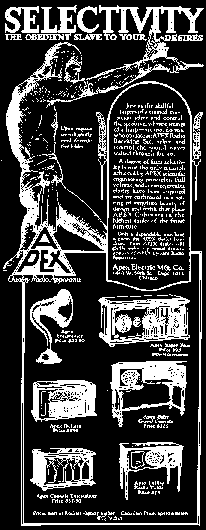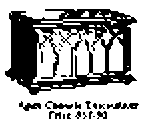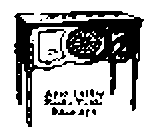The Golden Age
Manufacturers
of the 1920s
Volume I

Sometime in 1943, the Philco made its way down to my bedroom. At that point, it was almost as tall as I was. But then I grew, and it shrank. I set it up next to my bed. It was a floor model, with three smooth wooden supports in front of the speaker, which was hidden behind the filagree cloth.
It was well named The Cathedral --- tall and august, ready for worship. There was a green dial, lit from hidden lamps to the left and the right. There were bands for AM, Medium Wave, and Short Wave. The hinged top came down to hide the dial, if you wanted, so you'd be left only with a small burnt umber light, in the center, a hot naval --- so you could know that the Philco was beaming fearlessly on in the darkness.
The back of it was the holy lady with her clothes off: naked tubes and yellow curl condensers and strange bent wires and transformers, and the massive speaker, at least eight inches across, a five pound hunk of hardware with its huge electromagnet. The tubes operated with a soft glow, the glow of the sun at rising. Each tube had its distinctive shape and contour of filaments and mica --- but all had in common a thin pyre of fire, electrons streaming out so that you could see the energy that that brought the ghosts out of outer space.
 When you first turned it on, the glassine separators inside the 6SJ7's would burn blue for a moment, then settle down to reflect the deep russet of the filaments. Some of the tubes had shields to protect them (or you) from god know's what power being funneled through them (and you). Some had tiny hats, with a wire connector snaking down to the base. Some scarcely burned at all; others poured out a steady red fire. All worked together to pull in the sounds, working together in what they called Push-Pull, not unlike Dr. Doolittle's Push-Me-Pull-You. The whole smelled of wax, cooking, roasted out of the thick yellow condensors.
When you first turned it on, the glassine separators inside the 6SJ7's would burn blue for a moment, then settle down to reflect the deep russet of the filaments. Some of the tubes had shields to protect them (or you) from god know's what power being funneled through them (and you). Some had tiny hats, with a wire connector snaking down to the base. Some scarcely burned at all; others poured out a steady red fire. All worked together to pull in the sounds, working together in what they called Push-Pull, not unlike Dr. Doolittle's Push-Me-Pull-You. The whole smelled of wax, cooking, roasted out of the thick yellow condensors.
At the ends of the chassis were the heavies of reception: a black obese transformer, with eight colored wires snaking out of the sides. To the left, there was a delicate curved variable gang condenser --- ten shiny round plates moving within (but not touching) nine other shiny round plates. They moved as you moved the dial from station to station, from frequency to frequency, pointer moving across the green lit plate, moving a thin finger writ across the world, exotic cities limned on glass: Oslo, Tokyo, Moscow, Capetown, Buenos Aires, Berlin, Beirut, Belfast.
They moved as you moved the dial from station to station, from frequency to frequency, pointer moving across the green lit plate, moving a thin finger writ across the world, exotic cities limned on glass: Oslo, Tokyo, Moscow, Capetown, Buenos Aires, Berlin, Beirut, Belfast.